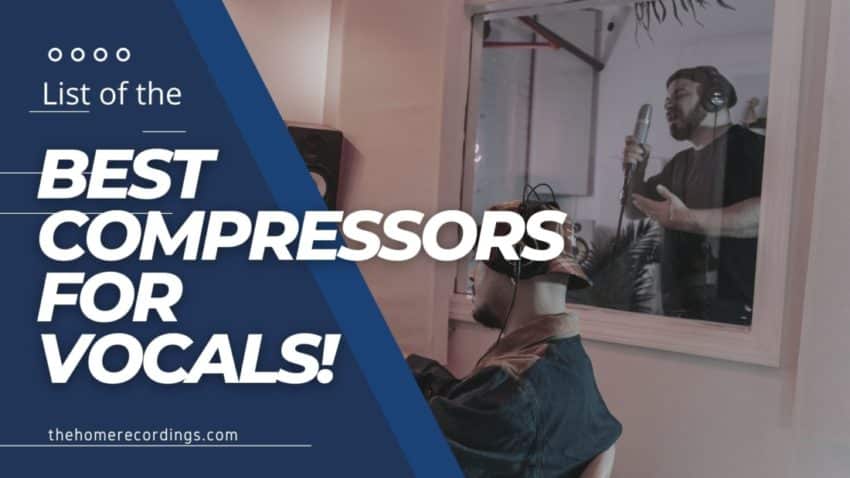Last updated on February 1st, 2024 at 10:01 pm
Compressors come in a lot of different varieties and flavors, and some of them may be more suited for processing instruments, such as drums, while others are better suited for vocals, and this is what I’ll be focusing on today.
In this article, I will provide you with a list of the Best Compressor VST Plugins for vocals currently available, and most of them are actually quite affordable as well.
So, without any further ado, let’s get started!
Best Compressor VST Plugins for Vocals
Testing the Plugins
I will be reviewing these plugins and running them through a series of tests, such as loading as many instances of the plugin as possible before artifacts appear during playback, and more.
Here’s a brief description of the testing process:
- Technical performance: Tested with Pluginval and Auval, loading as many instances of the plugins as possible on different tracks before audio playback is affected, testing oversampling, aliasing, latency, and more factors.
- User experience: From installation to actually using the plugin.
- Sound quality: Mostly checking if there are any issues since testing for whether it “sounds good” or not is mostly subjective.
- Economic Factors: Taking the maximum and minimum price of roughly 20 plugins of the same type and comparing that to the price of the plugin.
- Compatibility & Plugin formats.
- Plugin-specific Features: In this case, if they have auto makeup, auto attack and release, external sidechain processing, and so on.
Learn how the plugin testing process is done here.
Note: I tried a lot more compressors than the ones on this list, but these are the ones I found to be more suitable for most people, be it because of their price-to-performance, or just overall feature set, usability, sound quality, and so on.
THR Compactor
Powerful Compressor with Tempo-sync features!
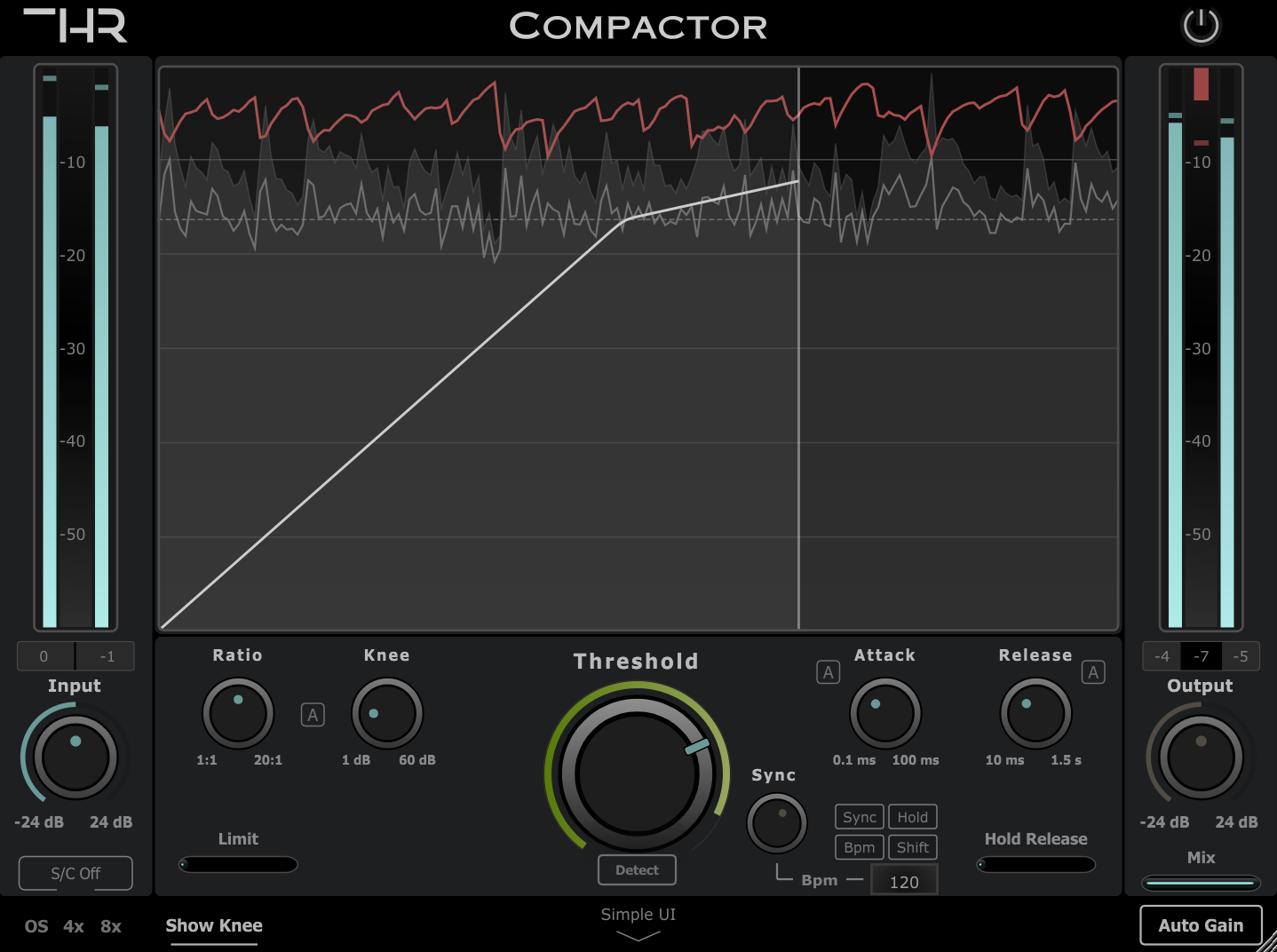
Price: $49.99.
The THR Compactor is a compressor that offers vocal-specific functionalities, such as an automatic knee that sets the knee and the ratio depending on the threshold level, resulting in a very natural-sounding vocal compression, auto attack & release, as well as some additional tempo-sync features, which makes dialing in the ideal compression levels fast & easy!
Its automatic gain makeup lets you to dial in the needed compression without having to worry about the output volume, and contrary to other compressors, it doesn’t just take into account the threshold and ratio in order to calculate the makeup, but also attack and release times, the knee, the mix percentage, and more, ensuring that you have a consistent output level no matter the settings.
Compactor offers two distinct interfaces: A Simple UI and an Advanced UI. Let’s go over what the simple UI has to offer:
Simple UI
Designed to let you dial in the ideal compression levels as fast as possible, the Simple UI focuses on the use of presets with a range of set parameters tailored for specific input signals, such as drum busses, guitars, vocals, etc., with the Vocal preset using the auto knee I mentioned earlier as well as adaptive release.
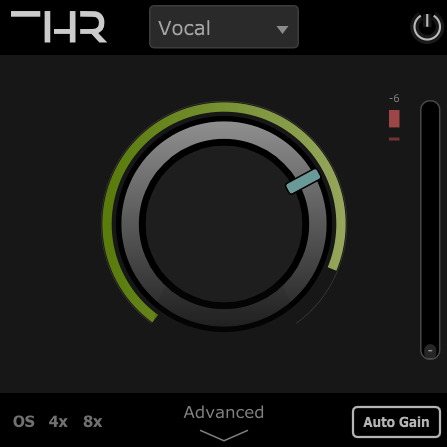
Simple UI Features:
- Threshold Control: Adjust the threshold control to achieve the desired level of compression.
- Tailored Presets: Included are a range of presets tailored to various audio sources, including drum buses, guitars, vocals, bass, and more.
- Auto Makeup: When enabled, you don’t need to worry about the output level changing while adjusting the compression since the Compactor does this for you.
- 4x and 8x Oversampling: The THR Compactor offers 4x and 8x oversampling options, reducing aliasing and improving the clarity of your compressed audio.
The Simple UI lets beginner producers learn about compression without getting overwhelmed and it’s also the perfect tool for seasoned producers to achieve a faster workflow.
Advanced UI
Here is where the Compactor provides you with granular control over the compression as well as some advanced features which are not that common in other compressors (such as synchronizing to the project’s tempo, holding the release, auto threshold, and more).
Advanced UI Features:
- Histogram Display: The histograms visually represents the input, compression, and post-compression audio levels.
- Knee Visualizer: You can enable or disable the knee visualizer to see the compression curve.
- Automatic Controls: Auto Knee, Attack, Release, and even Threshold (you can see it moving in real time).
- Oversampling: 4x and 8x oversampling to reduce aliasing.
- Gain Reduction Limit: Manually set the maximum gain reduction in dB and Compactor will never compress more than that.
- Tempo Sync Functionality: Compactor can sync the release to your project’s tempo, or even hold the release based on the Bpm to create some interesting rhythmic compression patterns.
| Average Score: | 9.65 |
| Technical Performance | 9.90 |
| User Experience | 9.83 |
| Sound Quality | 10 |
| Economic Factors/Price | 8.99 |
| Compatibility/Formats | 10 |
| Plugin-specific features | 8.10 |
| Criteria | Value | Score |
| PluginVal or AUVal (“Pass” = 10, “Fail” = 1) | Pass | 10 |
| Oversampling & Aliasing | 4x & 8x OS (removes aliasing). | 10 |
| Latency in MS | 0.5 | 9.91 |
| Latency with Oversampling (if it has the option) | 3 | 9.46 |
| Sidechain Compatible | Yes | 10 |
| CPU Consumption & Scalability (Max Simultaneous tracks…) | 323 | 10 |
| Average | 9.90 |
| Criteria | Value | Score |
| Installation, DRM and Licensing Restrictions | Simple Installer (no extra steps) | 10 |
| Free Trial Availability | 7-days | 10 |
| Interface Look and Feel, Intuitiveness, Responsiveness | Very responsive and intuitive | 10 |
| Ease of Use | Beginner friendly | 10 |
| Documentation and Learning Resources | Written Guide | 9 |
| Update and Support Policy | Lifetime Updates | 10 |
| Average | 9.83 |
| Criteria | Value | Score |
| Sound Fidelity, Sound Options | Transparent sound | 10 |
| Artifacts/Distortion | No Artifacts or Distortion | 10 |
| Average | 10 |
| Criteria | Value | Score |
| Price | $49.00 | |
| Min Price of Similar Plugins | $29.99 | |
| Max Price of Similar Plugins | $199.00 | |
| Average | 8.99 |
| Criteria | Value | Score |
| Formats | VST3, AU, AAX, 32-bit & 64-bit | 10 |
| Compatibility | Windows, MacOS, Linux | 10 |
| Average | 10 |
| Criteria | Value | Score |
| Auto Makeup Gain | Maintains perceived loudness almost perfectly. | 9.5 |
| Auto Attack & Release | Yes | 10 |
| Mid/Side Processing | No | 7 |
| RMS/Peak Detection Control | No | 7.00 |
| MIDI Learn | No | 7 |
| Average | 8.10 |
Lastly, Compactor comes with a 7-day free trial, so make sure to give it a try!
Find out more about Compactor here.
Waves CLA-2A
Simplest Vocal compression Plugin Available!
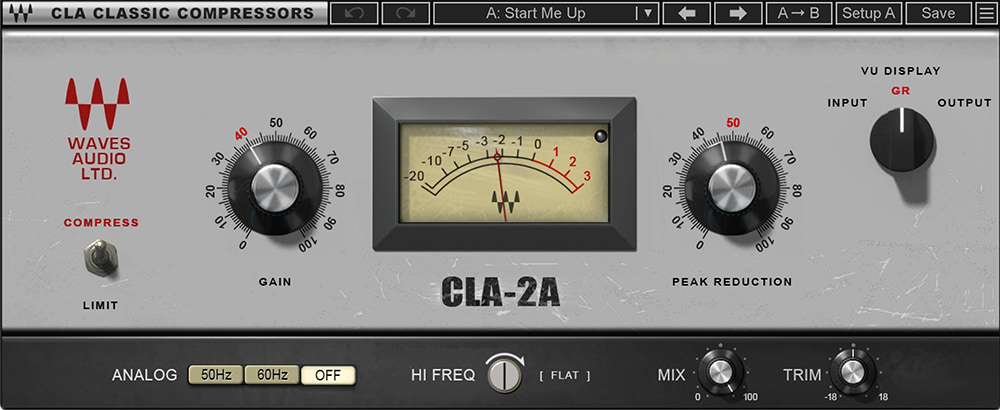
Price: $39.99.
The Waves CLA-2A is an optical compressor and is considered to be an industry standard and it’s used by none other than Chris Lord-Alge (Basically the guy mixing most major hits today).
What immediately stands out about the CLA-2A is its simplicity since it only features a handful of knobs and switches, starting off with the Compressor/Limiter switch which simply switches the ratio (about 3:1 when set to compressor and 100:1 when set to limiter mode).
Then you have the Gain knob which isn’t really an “input” level control but rather makeup Gain control, so basically increases the level after compression has taken place, and then you have the Peak Reduction knob which works as the Threshold.
The metering can be switched from input, output, and VU Display (how much gain is being reduced), and then it also features the “HiFreq” knob which, essentially, works as a Low-Pass filter, making the compressor clamp down only on the higher frequencies, similar to how a De-Esser would work.
Lastly, on the bottom it includes three switches: 50Hz, 60Hz, and Off, and these essentially introduce a bit of analog sound (Honestly, I always keep it Off), and it also comes with a Mix knob and a Trim Knob.
User Interface: The CLA-2A is by far the simplest compressor on this list since it only has two knobs, making it super easy to learn and use. However, compared to something like the THR Compactor which is a really visual plugin that lets you not just hear what is going on but also see what specific frequencies are being processed, some might find the CLA-2A to be a bit more “basic”, but the results speak for themselves and every professional music producer uses it.
Character: Since it’s based on anelectro-optical tube compressor, it introduces some warmth and character to the sound.
Distinctive Features:
- Sidechain frequency filter.
- Modeled after an electro-optical tube compressor.
- Simplest compressor plugin that yields extremely good results.
- Warm analog sound.
Uses: The CLA-2A works really well on vocals. It can be used on other sources as well, but it was designed as a vocal compressor and its analog sound adds that little bit of warmth as well.
| Average Score: | 9.13 |
| Technical Performance | 8.99 |
| User Experience | 9.17 |
| Sound Quality | 10 |
| Economic Factors/Price | 9.47 |
| Compatibility/Formats | 10 |
| Plugin-specific features | 6.00 |
| Criteria | Value | Score |
| PluginVal or AUVal (“Pass” = 10, “Fail” = 1) | Pass | 10 |
| Oversampling & Aliasing | No OS | 7 |
| Latency in MS | 0.5 | 9.91 |
| Latency with Oversampling (if it has the option) | No OS | 7 |
| Sidechain Compatible | Yes | 10 |
| CPU Consumption & Scalability (Max Simultaneous tracks…) | 361 | 10 |
| Average | 8.99 |
| Criteria | Value | Score |
| Installation, DRM and Licensing Restrictions | Waves Installer | 8 |
| Free Trial Availability | Forever but with sound cuts | 8 |
| Interface Look and Feel, Intuitiveness, Responsiveness | Very responsive and intuitive | 10 |
| Ease of Use | Beginner friendly | 10 |
| Documentation and Learning Resources | Written Guides & Videos | 10 |
| Update and Support Policy | Lifetime Updates (With Subscription) | 9 |
| Average | 9.17 |
| Criteria | Value | Score |
| Sound Fidelity, Sound Options | Analog-ish sound | 10 |
| Artifacts/Distortion | No Artifacts or Distortion | 10 |
| Average | 10 |
| Criteria | Value | Score |
| Price | $39.99 | |
| Min Price of Similar Plugins | $29.99 | |
| Max Price of Similar Plugins | $199.00 | |
| Average | 9.47 |
| Criteria | Value | Score |
| Formats | VST, VST3, AU, AAX, 32-bit & 64-bit | 10 |
| Compatibility | Windows, MacOS, Linux | 10 |
| Average | 10 |
| Criteria | Value | Score |
| Auto Makeup Gain | No | 7 |
| Auto Attack & Release | Yes (Release) | 9 |
| Mid/Side Processing | No | No |
| RMS/Peak Detection Control | No | 7.00 |
| MIDI Learn | No | 7 |
| Average | 6.00 |
You can get the Waves CLA-2A here: Waves Website, Sweetwater.
Tokyo Dawn Labs TDR Kotelnikov GE
Very Cost-efficient Compressor (Harder Learning Curve)!
Price: Free or $44.
The Kotelnikov is a program-dependent compressor (it can vary its response depending on the frequency content and amplitude of the signal) that doesn’t emulate any existing hardware compressors and rather focuses on fidelity (transparent sound).
Aside from the typical compressor controls such as Threshold, Ratio, Attack, and Release, it comes with individual controls for Release Peak and Release RMS, as well as a Gain Reduction Limit control, which essentially allows you to manually restrict the maximum gain reduction.
The GR Limit is useful when you find the perfect settings for most of the track but in very specific sections the compressor just clamps down on the signal too hard due to sudden volume changes, and this setting prevents it from over compressing the signal.
It also features a “Peak Crest” control which can go from “Peak” all the way to “RMS” detection, and this knob essentially lets you control how the compressor reacts to peaks (quickly or by averaging the input level).
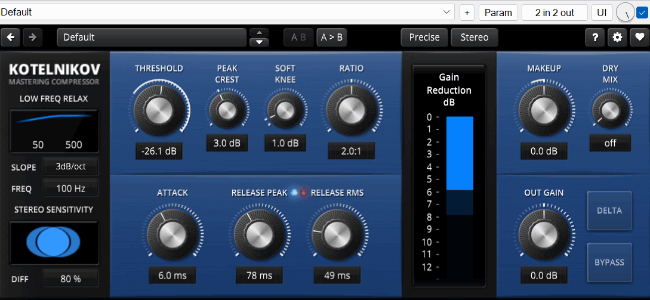
Another feature is the “Low Freq Relax” that lets you configure a high-pass filter for the sidechain, which makes the compressor react less to those lower frequencies such as kick and bass.
User Interface: The Kotelnikov has a ton of features packed into a compact interface, making it a bit harder to wrap your head around than other compressors at first.
Character: Kotelnikov is transparent-sounding and adds no character or coloration.
Uses: Kotelnikov is mainly designed for Bus Mixing or Mastering, but it can definitely be used to process individual tracks, such as vocals, as well. Just remember that it’s not a coloring compressor (which is why it’s great for mastering all kinds of music).
Notable Features:
- Low Frequency Relax (High Pass Filter on the Sidechain).
- Ying and Yang controls add harmonics to the lower and higher frequencies respectively.
- Inertia: Slower compression times with low Gain Reduction and vice versa.
- Frequency Dependent Ratio (can be adjusted in depth).
- Peak and RMS detection.
- GR Limit (Limit the gain reduction).
- Stereo, Mid/Side Processing.
Pros:
- Versatile control over the final sound.
- Useful for both mastering and mixing tasks.
- Freemium (the free version is generally all you need).
Cons:
- Some of the parameters might be harder to understand for beginners.
| Average Score: | 9.46 |
| Technical Performance | 9.00 |
| User Experience | 9.67 |
| Sound Quality | 10 |
| Economic Factors/Price | 9.25 |
| Compatibility/Formats | 10 |
| Plugin-specific features | 8.50 |
| Criteria | Value | Score |
| PluginVal or AUVal (“Pass” = 10, “Fail” = 1) | Pass | 10 |
| Oversampling & Aliasing | Yes (only compression delta) | 10 |
| Latency | 12 ms | 9.5 |
| Latency with Oversampling (if it has the option) | 12 ms | 9.5 |
| Sidechain Compatible | No | 10 |
| CPU Consumption & Scalability (Max Simultaneous tracks…) | 154.5 | 5 |
| Average | 9.00 |
| Criteria | Value | Score |
| Installation, DRM and Licensing Restrictions | Simple Installer (no extra steps) | 10 |
| Free Trial Availability | Freemium (Free version with upgrade) | 10 |
| Interface Look and Feel, Intuitiveness, Responsiveness | Very responsive and intuitive | 9 |
| Ease of Use | Beginner friendly | 9 |
| Documentation and Learning Resources | Written Guide & videos | 10 |
| Update and Support Policy | Lifetime Updates | 10 |
| Average | 9.67 |
| Criteria | Value | Score |
| Sound Fidelity, Sound Options | Transparent sound | 10 |
| Artifacts/Distortion | No Artifacts or Distortion | 10 |
| Average | 10 |
| Criteria | Value | Score |
| Price | $44.00 | |
| Min Price of Similar Plugins | $29.99 | |
| Max Price of Similar Plugins | $199.00 | |
| Average | 9.25 |
| Criteria | Value | Score |
| Formats | VST3, AU, AAX, 32-bit & 64-bit | 10 |
| Compatibility | Windows, MacOS, Linux | 10 |
| Average | 10 |
| Criteria | Value | Score |
| Auto Makeup Gain | No | 7 |
| Auto Attack & Release | No | 7 |
| Mid/Side Processing | Yes | 10 |
| RMS/Peak Detection Control | Yes | 10 |
| MIDI Learn | No | 7 |
| Built-In FIlter | Yes (Low Freq Relax) | 10 |
| Average | 8.50 |
Get TDR Kotelnikov GE Here: Pluginboutique, TDR Website.
Sonible Smart:Comp 2
A.I. powered spectro-dynamic compressor
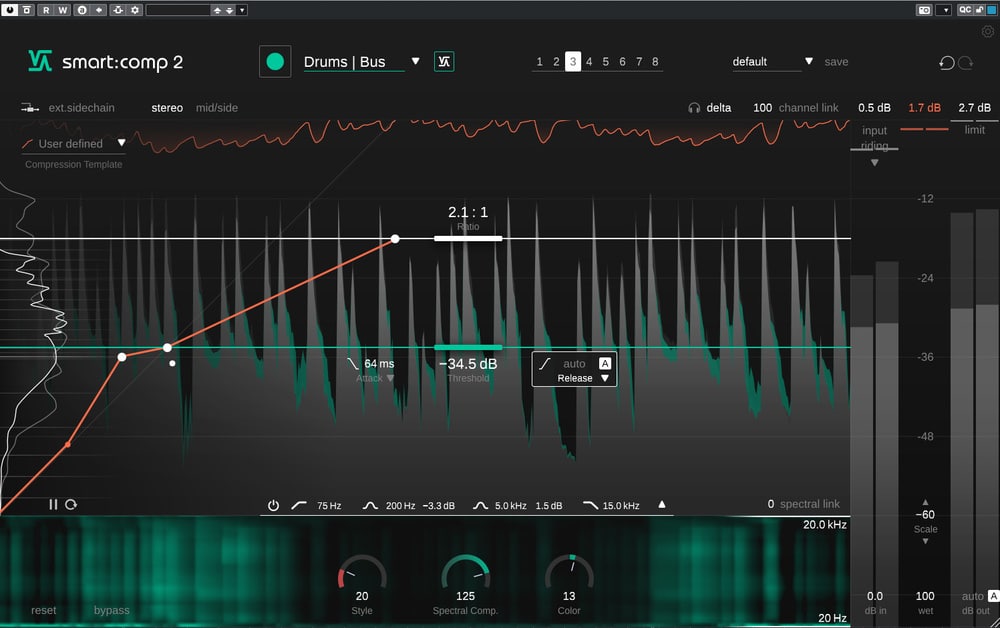
Price: $129.
Smart:comp 2 is on the cutting edge of technology as it is one of the very few compressors that takes advantage of A.I. in a useful way.
What sets Smart:comp apart from many other compressors is that it was trained using A.I. by feeding it a lot of different audio samples, allowing it to analyze your tracks and to choose the parameters as it sees fit, resulting in a very quick workflow.
Not only that, but being a “spectral” compressor means that it is, essentially, a multi-band compressor that can processes over 2000 bands at the same time, which enhances transparency because every band gets compressed depending on its own signal level.
By turning the spectral comp knob up, smart:comp will apply gain reduction to each of the bands in a different way, whereas turning it down makes the compression more “uniform”, or traditional-sounding.
It comes with a ton of presets for each type of audio (drums, guitars, vocals, etc.), it also offers granular control over the compression curve by letting you adjust the share of the attack and release curves, and more.
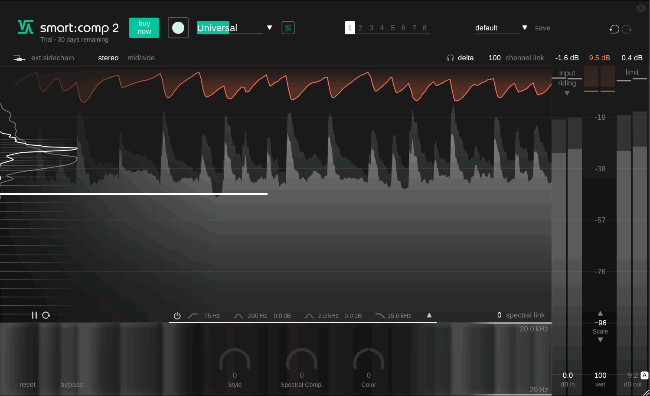
User Interface: The user interface can be a bit intimidating at first since it offers so many different controls and features, but it provides you with a lot of very useful information as well a great workflow (you almost never need to go menu diving). For example, on the left is the histogram, which shows the distribution of certain levels before and after applying compression, and this allows the user to understand how a compression curve morphs level distribution from the input to the output.
Then you have the more traditional waveform history that shows input, compression and output levels, and on the bottom you have the spectrogram that shows the different bands.
Character: Simple:Comp 2 sounds very transparent and natural (which is the whole idea behind spectral compression).
Distinctive Features:
- Auto makeup gain.
- About 2000 simultaneous bands.
- A.I. powered processing that selects the best settings for each situation (great starting point).
- Dozens of presets.
Uses: Smart:comp 2 is especially useful for working fast since you can let it choose the settings for you and then you simply adjust whet you need.
| Average Score: | 8.68 |
| Technical Performance | 7.07 |
| User Experience | 10.00 |
| Sound Quality | 10 |
| Economic Factors/Price | 4.73 |
| Compatibility/Formats | 10 |
| Plugin-specific features | 9.42 |
| Criteria | Value | Score |
| PluginVal or AUVal (“Pass” = 10, “Fail” = 1) | Pass | 10 |
| Oversampling & Aliasing | No OS | 7 |
| Latency | 42 | 2.44 |
| Latency with Oversampling (if it has the option) | No OS | 7 |
| Sidechain Compatible | Yes | 10 |
| CPU Consumption & Scalability (Max Simultaneous tracks…) | 165 | 6 |
| Average | 7.07 |
| Criteria | Value | Score |
| Installation, DRM and Licensing Restrictions | Simple Installer (no extra steps) | 10 |
| Free Trial Availability | 30 days | 10 |
| Interface Look and Feel, Intuitiveness, Responsiveness | Very responsive and intuitive | 10 |
| Ease of Use | Beginner friendly | 10 |
| Documentation and Learning Resources | Written Guide & videos | 10 |
| Update and Support Policy | Lifetime Updates | 10 |
| Average | 10.00 |
| Criteria | Value | Score |
| Sound Fidelity, Sound Options | Transparent sound | 10 |
| Artifacts/Distortion | No Artifacts or Distortion | 10 |
| Average | 10 |
| Criteria | Value | Score |
| Price | $129.00 | |
| Min Price of Similar Plugins | $29.99 | |
| Max Price of Similar Plugins | $199.00 | |
| Average | 4.73 |
| Criteria | Value | Score |
| Formats | VST, VST3, AU, AAX, 64-bit | 10 |
| Compatibility | Windows, MacOS, Linux | 10 |
| Average | 10 |
| Criteria | Value | Score |
| Auto Makeup Gain | Maintains perceived loudness almost perfectly. | 9.5 |
| Auto Attack & Release | Yes | 10 |
| Mid/Side Processing | Yes | 10 |
| RMS/Peak Detection Control | No | 7.00 |
| MIDI Learn | Yes | 10 |
| AI Help | Yes | 10 |
| Average | 9.42 |
Note: For being a 2048 band compressor, the smart:comp2 definitely uses way fewer resources than I anticipated, since I was able to load it on an average of 165 tracks simultaneously before playback started suffering.
Get Smart:comp 2 Here: Pluginboutique, Sonible website.
Distressor by Universal Audio
Faithful replica of the hardware counterpart

The Universal Audio Empirical Labs EL8 Distressor plugin is a meticulously crafted digital version of the renowned EL8 Distressor from Empirical Labs (hardware version).
This plugin runs on Windows and Mac, but if you have one of Universal Audio’s Apollo interfaces, it can be accelerated by the interface itself to improve CPU efficiency (There are multiple other audio interfaces with built-in DSP that have similar capabilities as well).
This plugin features a user-friendly interface with large, easy-to-tweak knobs and buttons. It offers various controls including Input, Attack, Release, Output, and a useful Dry/Comp Mix knob.
It also has a High-pass filter that cuts lows at 80Hz, a “Band Emphasis”, which essentially bumps the mids in the detection circuit, and modes for adding harmonic distortion (Dist 2 and Dist 3 modes) for warmth or more aggressive sounds.
The “mid bump” on the detector is often good for vocals and guitars, or any other mid-range instrument, but not so much for bass and drums, and the high pass is usually good on everything.
The Ratio button lets you scroll through various ratio options ranging from no compression (1:1 mode), moderate to high compression (4:1, 6:1), all the way to limiting (“Nuke”).
User Interface: The interface is identical to the hardware, with just a handful of knobs to tweak the sound.
Character: The Distressor is definitely a compressor that adds coloration and character to the signal as well as added harmonic content when engaging the saturation modules, making it a great choice for vocal compression.
Distinctive Features:
- High Pass Filter and Band Emphasis.
- Different saturation modules.
Uses: While Distressor’s main strength is being used as a drum compressor, it’s one of the best vocal compressors out there, and it’s also very simple to set up.
| Average Score: | 8.22 |
| Technical Performance | 6.77 |
| User Experience | 8.50 |
| Sound Quality | 10 |
| Economic Factors/Price | 6.33 |
| Compatibility/Formats | 10 |
| Plugin-specific features | 7.00 |
| Criteria | Value | Score |
| PluginVal or AUVal (“Pass” = 10, “Fail” = 1) | Pass | 10 |
| Oversampling & Aliasing | No OS | 7 |
| Latency | 25 | 6.59 |
| Latency with Oversampling (if it has the option) | No OS (Score 7) | 7 |
| EXT Sidechain Compatible | No | 7 |
| CPU Consumption & Scalability (Max Simultaneous tracks…) | 78.5 | 3 |
| Average | 6.77 |
| Criteria | Value | Score |
| Installation, DRM and Licensing Restrictions | UA Connect Downloader + iLok | 1 |
| Free Trial Availability | 14-days | 10 |
| Interface Look and Feel, Intuitiveness, Responsiveness | Very intuitive | 10 |
| Ease of Use | Beginner Friendly | 10 |
| Documentation and Learning Resources | Written Guides and videos | 10 |
| Update and Support Policy | Lifetime Updates | 10 |
| Average | 8.50 |
| Criteria | Value | Score |
| Sound Fidelity, Sound Options | Faithful Replica (analog sound) | 10 |
| Artifacts/Distortion | No Artifacts or Distortion | 10 |
| Average | 10 |
| Criteria | Value | Score |
| Price | $99.00 | |
| Min Price of Similar Plugins | $29.99 | |
| Max Price of Similar Plugins | $199.00 | |
| Average | 6.33 |
| Criteria | Value | Score |
| Formats | VST3, AU, AAX, 64-bit | 10 |
| Compatibility | Windows, MacOS, Linux | 10 |
| Average | 10 |
| Criteria | Value | Score |
| Auto Makeup Gain | No | 7 |
| Auto Attack & Release | No | 7 |
| Mid/Side Processing | No | 7 |
| RMS/Peak Detection Control | No | 7 |
| MIDI Learn | No | 7 |
| Volume Matching of any kind | No | 7 |
| Average | 7.00 |
Get Distressor Here: Pluginboutique, Universal Audio.
Waves SSL E-Channel
SSL Channel Strip with Great Vocal Compressor!
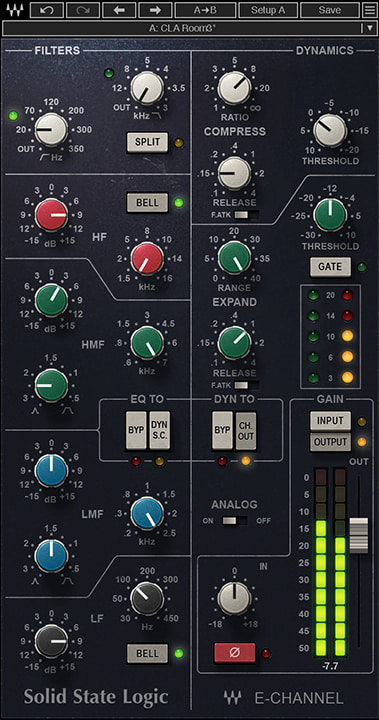
Price: $35.99.
The Waves SSL E-Channel is based on the Solid State Logic 4000-series console’s all-discrete design and its Class A, VCA chip, and these SSL consoles are the ones that have been used throughout the years to create numerous amounts of hits.
The SSL E-Channel is divided up into distinct sections: Filters (these come first in the chain) which can be adjusted to cut off some frequencies depending on the track’s needs, then Compression, and then EQ.
The EQ can be moved in from of the compressor depending on how you want to process the sound by pressing the “Channel Out” button.
The compression section only features four controls: Ratio, Threshold, Release, and the F. Attack Switch, which essentially lets you choose between a slow attack and a slightly faster one (none of them are really that fast).
There are many more controllable parameters on this plugin, like the EQ and the Filters, as well as LMF and HMF peak bands, and more, as I mentioned in the beginning, but I won’t go into detail since we’re mainly focusing on the compressor section. Just know that it’s not just a compressor plugin that works really well for vocals, but it’s actually a lot more.
User Interface: The Waves SSL E-Channel is a very simple and straightforward plugin to use and this is mainly because of the interface which essentially looks just like, well, the channel strip of the SLL-4000 console. It only features a handful of knobs and switches and that’s it, and you should be able to use all of its included features in no time.
Character: This plugin does add a bit of character and grit to the signal, which is also why you may want to use it as a second compressor on the vocals (use a transparent one first to tame the vocals and then use the E-channel to add something like -3 to -4dB reduction to further compress the sound and add some color).
Distinctive Features:
- Extremely easy to use.
- Zero Latency.
- Not just a compressor (Includes filters, EQ section, and more).
- Great for vocals, acoustic or electric guitar, basses, and even drums.
Uses: The SSL E-Channel is one of the most versatile plugins out there, especially considering how easy it is to use, which means that you can probably get away with using it on any track (I would highly suggest trying it out as a second compressor when processing vocals). Just remember that it may add some color or grit to the sound.
| Average Score: | 9.25 |
| Technical Performance | 8.99 |
| User Experience | 9.17 |
| Sound Quality | 10 |
| Economic Factors/Price | 9.68 |
| Compatibility/Formats | 10 |
| Plugin-specific features | 7.00 |
| Criteria | Value | Score |
| PluginVal or AUVal (“Pass” = 10, “Fail” = 1) | Pass | 10 |
| Oversampling & Aliasing | No OS | 7 |
| Latency in MS | 0.5 | 9.91 |
| Latency with Oversampling (if it has the option) | No OS | 7 |
| Sidechain Compatible | Yes | 10 |
| CPU Consumption & Scalability (Max Simultaneous tracks…) | 355 | 10 |
| Average | 8.99 |
| Criteria | Value | Score |
| Installation, DRM and Licensing Restrictions | Waves Installer | 8 |
| Free Trial Availability | Forever but with sound cuts | 8 |
| Interface Look and Feel, Intuitiveness, Responsiveness | Very responsive and intuitive | 10 |
| Ease of Use | Beginner friendly | 10 |
| Documentation and Learning Resources | Written Guides & Videos | 10 |
| Update and Support Policy | Lifetime Updates (With Subscription) | 9 |
| Average | 9.17 |
| Criteria | Value | Score |
| Sound Fidelity, Sound Options | SSL-style sound | 10 |
| Artifacts/Distortion | No Artifacts or Distortion | 10 |
| Average | 10 |
| Criteria | Value | Score |
| Price | $35.99 | |
| Min Price of Similar Plugins | $29.99 | |
| Max Price of Similar Plugins | $199.00 | |
| Average | 9.68 |
| Criteria | Value | Score |
| Formats | VST, VST3, AU, AAX, 32-bit & 64-bit | 10 |
| Compatibility | Windows, MacOS, Linux | 10 |
| Average | 10 |
| Criteria | Value | Score |
| Auto Makeup Gain | No | 7 |
| Auto Attack & Release | No | 7 |
| Mid/Side Processing | No | 7 |
| RMS/Peak Detection Control | No | 7.00 |
| MIDI Learn | No | 7 |
| Average | 7.00 |
You can get the Waves SSL E-Channel here: Waves Website, Sweetwater, Best Service.
Bonus: Don’t ignore your Stock Plugins
People often think that the plugins that come with the DAW are lower quality than any of the more “premium” offers, and I think that this is especially the case with compressors and limiters.
The compressor that comes stock with your DAW is more than capable of yielding great results if you know how to use it properly.
In some cases, the built-in features may not be as advanced, but if you take the time to dial in the settings correctly, the end result should sound almost identical and you don’t need to spend your extra cash on external plugins.
How to Choose a Compressor VST Plugin for Vocals
There are hundreds, if not thousands, of compressors out there, which clearly means that there is no one size fits all solution. So, how do you choose which one to get?
As I mentioned before, learn to use your stuck plugins first. You might be surprised with the results!
I think that there are three main things you need to look out for:
Functionality: Of course, processing just the vocal track doesn’t require the compressor to have a lot of features but to do the job well. Having one with an automatic knee, for example, which results in a very natural-sounding vocal, can be useful. Also getting one with sidechain capabilities to duck other frequencies when the vocal needs to be present is almost a necessity.
Cost: Generally speaking, the more features and functionality a compressor has, the more expensive it will be, but don’t just buy the consider using simple compressors for this (stock compressors also work wonders).
Ease of Use: This point is especially true if you’re an absolute beginner, but using a compressor for the first time that comes with a lot of built-in features and functionality can really make you waste a lot of time and not really provide the results you need.
What about multiband compressors?
Multiband compressors have more “niche” uses than wide-band compressors and are generally used to adjust the frequency content as well as the dynamics, similar to a dynamic EQ.
As far as vocals go, nine times out of ten, reaching for a wide-band compressor is the way to go, but multiband compressors can give you more in-depth control over the signal, albeit at the expense of being harder to learn and use.
You should definitely read the article I wrote about the Best Multiband compressors since I also ran the same tests as I did with the ones on this list, so you’ll find plenty of useful information there.
Top Recommendation
Recommending a vocal compressor plugin is actually a lot simpler than recommending one in general since it just needs to do one thing well, but since being able to properly hear the vocals also entails moving competing frequencies out of the way, I decided to include compressors on this list that also have sidechain compatibility and allow for ducking of other frequencies when the vocals need to be more present.
This is why my Top recommendation is the THR Compactor since it does everything and really well.
However, if you’re someone who is just getting started with mixing vocals and want a plugin that is easy to use and simply works, then get the Waves CLA-2A since it only features a handful of controls, plus all the pros use it, which clearly means something.
Consider your DAW’s Compressor plugin
All major DAWs come with their own plugin set and you should always be able to find at least one compressor on there.
Generally speaking, these compressors are rather simple, meaning that they don’t offer sidechain capabilities, filters, etc., but they do allow you to really adjust the compression parameters in-depth, such as the Ratio, Knee, Attack, Release, etc.
So, don’t shy away from giving your DAW’s compressor a try, or any other included plugin for that matter.
Conclusion
Compressors are some of the most sought-after vocal plugins for creating professional quality music. Of course, there are many different compressor plugins out there and they all work completely different or at least come with a whole different feature set, but if you’re interested in music production, mixing and mastering vocals properly, then you need to get at least one high-quality compressor.
Of course, the one that comes included with your DAW will generally be enough to get you started, but I’d recommend getting one or two that sound different or that offer some added functionality.
